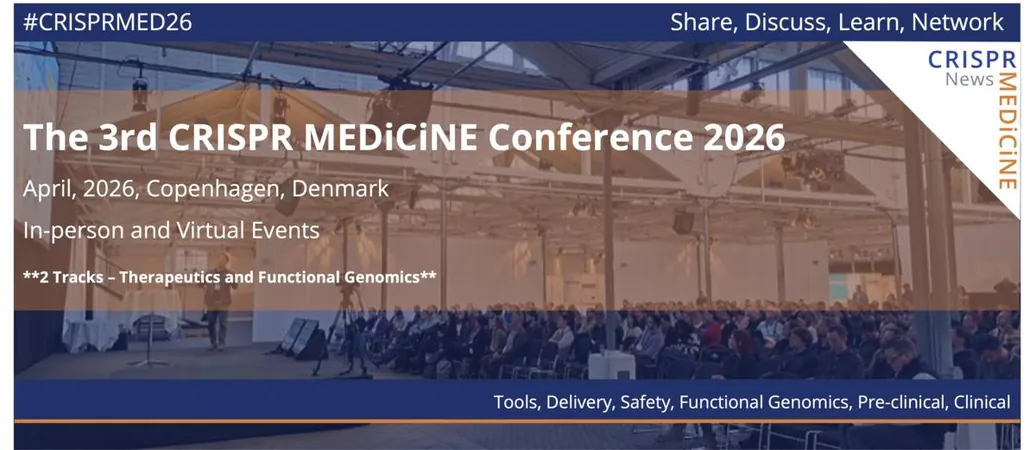
Revolutionizing Hepatitis Treatment: Uncovering the Hidden Epidemic
2025-04-17
Author: Wei Ling
The Fight Against Viral Hepatitis Hits Central Stage
The recent ESCMID Global 2025 conference in Vienna spotlighted a pressing health crisis: viral hepatitis. Despite being one of the deadliest infectious diseases globally, the fight to eliminate it by 2030 faces daunting challenges.
The Alarming Statistics
In 2024, a report from the World Health Organization revealed that aside from tuberculosis, viral hepatitis remains the leading cause of infectious disease mortality. While there's a slight decrease in global cases of hepatitis B (HBV) and C (HCV), deaths from these infections are on the rise. To combat this, the WHO initiated a Global Health Sector Strategy in 2016 aiming for a staggering 90% reduction in incidence and a 65% cut in mortality rates by 2030.
Tackling Undiagnosed Cases: A Major Hurdle
One significant barrier to achieving these ambitious goals is the shocking number of undiagnosed cases. In 2022, approximately 254 million people were estimated to have HBV globally, yet only 10% received a diagnosis. For HCV, the numbers were equally stark, with 50 million infections and just 30% diagnosed.
Innovative Testing Strategies on the Rise
To bridge this gap, healthcare providers are turning to reflex testing—an innovative method that allows for additional testing based on initial results. This process can effectively provide comprehensive diagnostic data using just one patient sample. For instance, a positive hepatitis B surface antigen result could trigger immediate testing for hepatitis D virus antibodies, drastically improving the identification of coinfections.
Remarkable Outcomes from Reflex Testing
Recent studies, such as a 2023 investigation by Rohit Nathani published in the Journal of Viral Hepatitis, underscored the effectiveness of reflex testing. The study followed over 11,000 HBV patients, revealing that 12.9% were screened for HDV. Alarmingly, 18% of those who tested positive for HDV would have been overlooked without this testing approach. The European Association for the Study of the Liver also emphasized the necessity of routine screening, noting a five-fold increase in HDV diagnoses through reflex methods.
Embracing Proactive Screening with Opt-Out Testing
Another promising approach is opt-out testing, which automatically tests patients for bloodborne viruses when they enter emergency departments. Trials in London saw nearly 2,000 new HBV cases and over 760 HCV infections detected, illustrating the potential of this proactive strategy.
Reaching the 'Hard-to-Reach' Populations
Despite these advancements, significant barriers remain in accessing care for vulnerable populations such as injectable drug users, prisoners, and ethnic minorities. Tailored strategies—integrating hepatitis care into existing healthcare frameworks, expanding access, and addressing stigma—are critical in reaching these individuals.
The Path Forward: A Collaborative Approach
Ultimately, the goal of eliminating viral hepatitis demands a multi-faceted, collaborative strategy involving healthcare professionals and community engagement. With continued innovation and commitment, the public health community can turn the tide against this hidden epidemic.


 Brasil (PT)
Brasil (PT)
 Canada (EN)
Canada (EN)
 Chile (ES)
Chile (ES)
 Česko (CS)
Česko (CS)
 대한민국 (KO)
대한민국 (KO)
 España (ES)
España (ES)
 France (FR)
France (FR)
 Hong Kong (EN)
Hong Kong (EN)
 Italia (IT)
Italia (IT)
 日本 (JA)
日本 (JA)
 Magyarország (HU)
Magyarország (HU)
 Norge (NO)
Norge (NO)
 Polska (PL)
Polska (PL)
 Schweiz (DE)
Schweiz (DE)
 Singapore (EN)
Singapore (EN)
 Sverige (SV)
Sverige (SV)
 Suomi (FI)
Suomi (FI)
 Türkiye (TR)
Türkiye (TR)
 الإمارات العربية المتحدة (AR)
الإمارات العربية المتحدة (AR)